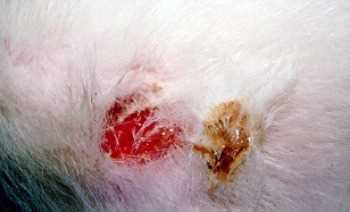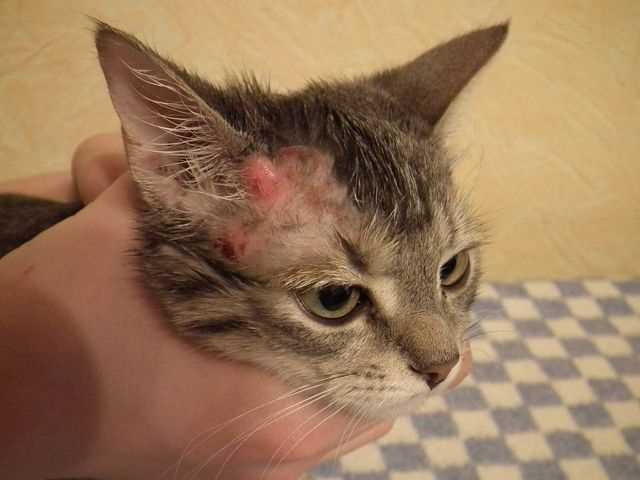



It’s crucial to recognize that skin irritations in furry friends often stem from allergies, parasites, or infections. If you notice excessive licking, biting, or scratching in your companion, immediate action is necessary. Consult a veterinarian to determine the underlying cause and initiate appropriate treatment.
Common triggers include flea infestations, food sensitivities, or environmental allergens such as pollen or dust mites. Regular grooming and a clean living environment can significantly reduce the risk of these irritants affecting your beloved pet. Incorporating a balanced diet with high-quality ingredients also plays a vital role in maintaining skin health.
Being observant of your feline’s behavior is key. If you spot red, inflamed patches or areas with hair loss, these may indicate a more serious issue requiring veterinary attention. Ensure your furry friend is comfortable, and monitor their habits closely to catch any problems early on.
Identifying the Symptoms of Hot Spots in Cats
Redness and inflammation on the skin are immediate indicators of irritation. You might notice your feline friend excessively grooming a particular area, which could lead to hair loss. Pay attention to any swelling or warmth in the affected region; these signs often signify an ongoing issue.
Observe for signs of discomfort such as scratching or biting at the area. Vocalizations or changes in behavior can also hint at distress. If you spot any oozing or crusty scabs, it’s crucial to take action. The presence of these symptoms can indicate a more severe problem requiring prompt attention.
Keep an eye on your kitty’s appetite. A decrease in eating or drinking could signal that something is wrong. If you suspect an issue, consider checking for any changes in your pet’s environment or diet that might contribute to discomfort. You can also explore helpful resources, like whether can i give my cat olive oil for hairballs is suitable for your furry friend.
Monitoring your pet is key. If you identify these symptoms, consulting a veterinarian is advisable to address the root cause and find relief for your beloved companion. Also, ensure to review their nutrition, as factors like dry food may affect overall health. For more information, check out is dry food bad for cats kidneys.
Common Causes of Irritation in Feline Health
Skin infections stemming from allergies are a frequent issue. Environmental triggers like pollen, dust mites, and certain foods can lead to excessive scratching and biting, which damages the skin.
Parasites such as fleas and mites are notorious culprits. The irritation they cause can prompt obsessive grooming, resulting in bare patches and inflammation.
Stress is another factor. Changes in the environment, like moving or the introduction of new pets, can lead to behavioral issues, manifesting as skin problems.
Infections and Underlying Conditions

Bacterial infections often follow breaks in the skin. Any injury from grooming or scratching can become a breeding ground for bacteria, leading to more severe health issues.
Underlying health conditions, including hormonal imbalances and autoimmune disorders, may also contribute. Regular check-ups help detect these issues early.
Grooming Practices

Improper grooming can exacerbate skin problems. Regular brushing helps prevent matting and removes loose fur, which can irritate sensitive skin. Maintaining a clean environment is equally important.
It’s crucial to recognize that skin irritations in furry friends often stem from allergies, parasites, or infections. If you notice excessive licking, biting, or scratching in your companion, immediate action is necessary. Consult a veterinarian to determine the underlying cause and initiate appropriate treatment.
Common triggers include flea infestations, food sensitivities, or environmental allergens such as pollen or dust mites. Regular grooming and a clean living environment can significantly reduce the risk of these irritants affecting your beloved pet. Incorporating a balanced diet with high-quality ingredients also plays a vital role in maintaining skin health.
Being observant of your feline’s behavior is key. If you spot red, inflamed patches or areas with hair loss, these may indicate a more serious issue requiring veterinary attention. Ensure your furry friend is comfortable, and monitor their habits closely to catch any problems early on.
Identifying the Symptoms of Hot Spots in Cats
Redness and inflammation on the skin are immediate indicators of irritation. You might notice your feline friend excessively grooming a particular area, which could lead to hair loss. Pay attention to any swelling or warmth in the affected region; these signs often signify an ongoing issue.
Observe for signs of discomfort such as scratching or biting at the area. Vocalizations or changes in behavior can also hint at distress. If you spot any oozing or crusty scabs, it’s crucial to take action. The presence of these symptoms can indicate a more severe problem requiring prompt attention.
Keep an eye on your kitty’s appetite. A decrease in eating or drinking could signal that something is wrong. If you suspect an issue, consider checking for any changes in your pet’s environment or diet that might contribute to discomfort. You can also explore helpful resources, like whether can i give my cat olive oil for hairballs is suitable for your furry friend.
Monitoring your pet is key. If you identify these symptoms, consulting a veterinarian is advisable to address the root cause and find relief for your beloved companion. Also, ensure to review their nutrition, as factors like dry food may affect overall health. For more information, check out is dry food bad for cats kidneys.
Common Causes of Irritation in Feline Health
Skin infections stemming from allergies are a frequent issue. Environmental triggers like pollen, dust mites, and certain foods can lead to excessive scratching and biting, which damages the skin.
Parasites such as fleas and mites are notorious culprits. The irritation they cause can prompt obsessive grooming, resulting in bare patches and inflammation.
Stress is another factor. Changes in the environment, like moving or the introduction of new pets, can lead to behavioral issues, manifesting as skin problems.
Infections and Underlying Conditions

Bacterial infections often follow breaks in the skin. Any injury from grooming or scratching can become a breeding ground for bacteria, leading to more severe health issues.
Underlying health conditions, including hormonal imbalances and autoimmune disorders, may also contribute. Regular check-ups help detect these issues early.
Grooming Practices

Improper grooming can exacerbate skin problems. Regular brushing helps prevent matting and removes loose fur, which can irritate sensitive skin. Maintaining a clean environment is equally important.
It’s crucial to recognize that skin irritations in furry friends often stem from allergies, parasites, or infections. If you notice excessive licking, biting, or scratching in your companion, immediate action is necessary. Consult a veterinarian to determine the underlying cause and initiate appropriate treatment.
Common triggers include flea infestations, food sensitivities, or environmental allergens such as pollen or dust mites. Regular grooming and a clean living environment can significantly reduce the risk of these irritants affecting your beloved pet. Incorporating a balanced diet with high-quality ingredients also plays a vital role in maintaining skin health.
Being observant of your feline’s behavior is key. If you spot red, inflamed patches or areas with hair loss, these may indicate a more serious issue requiring veterinary attention. Ensure your furry friend is comfortable, and monitor their habits closely to catch any problems early on.
Identifying the Symptoms of Hot Spots in Cats
Redness and inflammation on the skin are immediate indicators of irritation. You might notice your feline friend excessively grooming a particular area, which could lead to hair loss. Pay attention to any swelling or warmth in the affected region; these signs often signify an ongoing issue.
Observe for signs of discomfort such as scratching or biting at the area. Vocalizations or changes in behavior can also hint at distress. If you spot any oozing or crusty scabs, it’s crucial to take action. The presence of these symptoms can indicate a more severe problem requiring prompt attention.
Keep an eye on your kitty’s appetite. A decrease in eating or drinking could signal that something is wrong. If you suspect an issue, consider checking for any changes in your pet’s environment or diet that might contribute to discomfort. You can also explore helpful resources, like whether can i give my cat olive oil for hairballs is suitable for your furry friend.
Monitoring your pet is key. If you identify these symptoms, consulting a veterinarian is advisable to address the root cause and find relief for your beloved companion. Also, ensure to review their nutrition, as factors like dry food may affect overall health. For more information, check out is dry food bad for cats kidneys.
Common Causes of Irritation in Feline Health
Skin infections stemming from allergies are a frequent issue. Environmental triggers like pollen, dust mites, and certain foods can lead to excessive scratching and biting, which damages the skin.
Parasites such as fleas and mites are notorious culprits. The irritation they cause can prompt obsessive grooming, resulting in bare patches and inflammation.
Stress is another factor. Changes in the environment, like moving or the introduction of new pets, can lead to behavioral issues, manifesting as skin problems.
Infections and Underlying Conditions

Bacterial infections often follow breaks in the skin. Any injury from grooming or scratching can become a breeding ground for bacteria, leading to more severe health issues.
Underlying health conditions, including hormonal imbalances and autoimmune disorders, may also contribute. Regular check-ups help detect these issues early.
Grooming Practices

Improper grooming can exacerbate skin problems. Regular brushing helps prevent matting and removes loose fur, which can irritate sensitive skin. Maintaining a clean environment is equally important.











